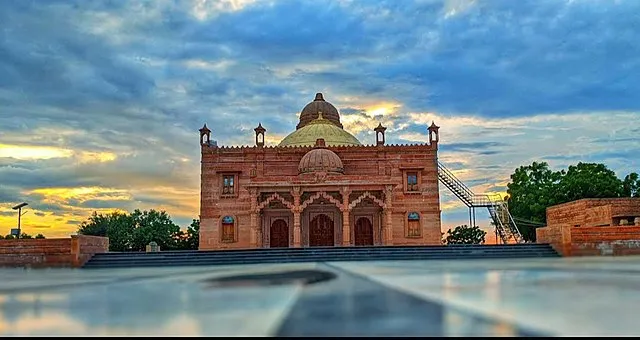Table of Contents
ToggleIntroduction
The annals of environmental activism in India are etched with tales of courage and sacrifice. One such poignant chapter is the Khejarli Massacre, a tragic event that unfolded in 1730, igniting a spark that would later fuel the Chipko Movement. This article delves into the historical context, the heroic actions of the Bishnoi community, and the enduring legacy of this movement.

Historical Context

The Bishnoi Community
The Bishnoi community, a sect of Hinduism, is renowned for its strict adherence to the principles of non-violence (ahimsa) and environmental conservation. Their philosophy emphasizes the sanctity of all living beings and the importance of preserving nature.
The Royal Demand:
In 1730, the Maharaja of Jodhpur, Abhay Singh, ordered the felling of khejri trees to procure wood for constructing a new palace. The khejri tree, revered by the Bishnois, is a hardy species that thrives in arid regions and plays a vital role in ecological balance.
The Heroic Stand of the Bishnois
Amrita Devi Bishnoi:
Amrita Devi, a devout Bishnoi woman, led the resistance against the royal order. She, along with her daughters and numerous villagers, embraced the trees, refusing to let them be cut down.
The Ultimate Sacrifice:
The royal officials, undeterred, resorted to violence. In a tragic turn of events, 363 Bishnois, including Amrita Devi, were brutally killed as they clung to the trees. Their sacrifice became a powerful symbol of environmental protection.
The Legacy of Khejarli

A Catalyst for Change:
The Khejarli Massacre ignited a spark of environmental consciousness that reverberated through the centuries. It laid the foundation for future environmental movements, including the Chipko Movement.
Inspiring the Chipko Movement:
The Chipko Movement, which emerged in the 1970s, drew inspiration from the Bishnois’ courageous act. It involved villagers in the Himalayan region hugging trees to prevent their felling, echoing the spirit of the Khejarli martyrs.
The Chipko Movement: A Testament to People Power
The Rise of the Chipko Movement
- The Threat to Forests: In the 1970s, the Indian Himalayan region faced deforestation due to commercial logging and the construction of dams. This threatened the livelihoods of local communities and the delicate ecological balance.
- The People’s Resistance: Inspired by the principles of Gandhian non-violence, villagers in the Garhwal and Kumaon regions of Uttarakhand united to protect their forests. They embraced the trees, forming human chains to prevent their felling.
Key Figures and Strategies
- Sunderlal Bahuguna: A prominent environmental activist, Sunderlal Bahuguna emerged as the leader of the Chipko Movement. He championed the cause of forest conservation and inspired countless people to join the struggle.
- Chandi Prasad Bhatt: Another key figure, Chandi Prasad Bhatt, played a crucial role in organizing and mobilizing the villagers. He emphasized the importance of self-reliance and sustainable development.
- Non-Violent Resistance: The Chipko Movement employed non-violent methods, including peaceful protests, tree hugging, and civil disobedience, to resist the destruction of forests.
The Impact of the Chipko Movement
Forest Conservation:
The Chipko Movement achieved significant success in halting deforestation and protecting the Himalayan forests. It led to a ban on commercial logging in the region.
Empowerment of Communities:
The movement empowered local communities to take control of their natural resources and participate in decision-making processes.
A Global Impact:
The Chipko Movement inspired similar environmental movements worldwide, highlighting the power of people’s participation in conservation efforts
The Enduring Legacy
The Khejarli Massacre and the Chipko Movement stand as enduring symbols of environmental activism and human resilience. They remind us of the importance of preserving our planet and the power of collective action. The sacrifices made by the Bishnois and the Chipko activists continue to inspire generations to protect nature and work towards a sustainable future.
Conclusion
The Khejarli Massacre and the Chipko Movement are testaments to the indomitable spirit of human beings in the face of environmental degradation. They remind us that even the smallest actions can have a significant impact on the planet. By honoring the sacrifices of these brave individuals, we can strive to create a world where harmony between humans and nature prevails.
FAQs
What is the significance of the khejri tree to the Bishnoi community?
The khejri tree holds immense religious and ecological significance for the Bishnois. It is considered sacred and is an integral part of their cultural heritage. The tree provides sustenance, shade, and fuelwood, making it essential for the survival of the community.
How did the Khejarli Massacre inspire the Chipko Movement?
The heroic sacrifice of the Bishnois demonstrated the power of non-violent resistance and the importance of protecting nature.
This inspired the Chipko activists to adopt similar strategies to safeguard their forests.
What were the key demands of the Chipko Movement?
The Chipko Movement demanded a ban on commercial logging, the involvement of local communities in forest management, and the promotion of sustainable livelihoods.
What are the long-term impacts of the Chipko Movement?
The Chipko Movement had a profound impact on environmental conservation in India.
It led to the recognition of the rights of local communities over forest resources, the promotion of eco-development, and the development of sustainable forestry practices.
How can we learn from the legacy of the Khejarli Massacre and the Chipko Movement?
We can learn from the legacy of these movements by embracing the principles of non-violence, respecting nature, and actively participating in environmental conservation efforts. By working together, we can create a sustainable future for all.






